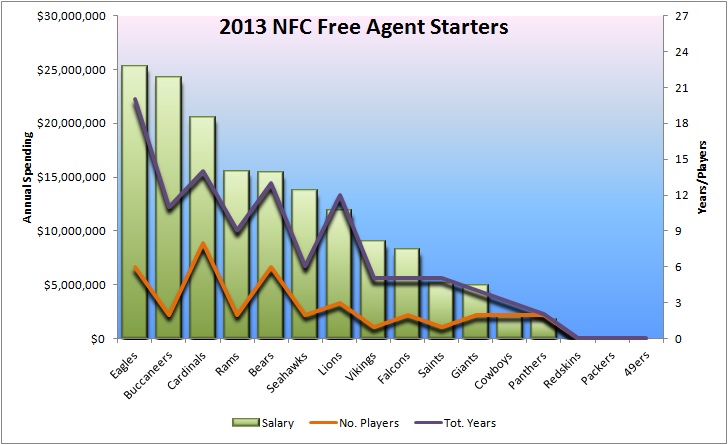[adsenseyu1]
As requested we will take our look at the NFC’s approach to using free agency to find starters in 2013. Just as a reminder we consider trades if the players traded signed new contracts with the acquiring team, which makes players such as Carson Palmer count as a free agent acquisition. The rosters are determined based on Ourlads current depth charts with the exception of the Seahawks where I did include Percy Harvin simply because he was expected to start.
The first thing that jumps out when looking at the data is the difference between the AFC and NFC in approaching free agency, which I think plays to the fact that the NFC is the more dominant conference with teams having less need to change their rosters. On average the AFC has 3.75 new starters per team while the NFC has just 2.44. The NFC quality of free agent was considerably higher as teams were looking for at the approach of bringing in talent to complete the puzzle and help push the team over the top.
All told three NFC teams brought in no free agents to start for their club. Those teams were the Packers, Redskins, and 49’ers. The Vikings and Saints both brought in just one each. The Steelers and Bengals were the only AFC teams to have that low of a level of activity.
The team to do the largest overhaul of their roster was the Cardinals, who tied for most in the NFL with 8 free agents. However their spending was moderate at just $20 million per year in new salaries and with no players signing for more than 3 years this was not the win now with big money spending approach of the Dolphins nor long term vision of the Colts. I tend to think this was a team desperately clinging to the amount of money invested in Larry Fitzgerald, Darnell Dockett, Darryl Washington, and Calais Campbell and trying to piece together a team around them that makes that spending result in wins. Their big pick up was Carson Palmer.
The Eagles spent more money than anyone else in the NFC and 3rd most in the NFL. Like the Cardinals most of the contracts were shorter term (five were 2 or 3 years) but on higher priced players. That plays to the fact that the Eagles did not have a great deal of talent to begin with as well as an approach to likely work in two and three year windows. This will be Phase I of Chip Kelley’s program and would represent places where perhaps the team would prefer to not invest in the draft.
The Bears were the only other team to add more than five new starters, but they were almost all short term moves to just get by on the 2013 season. Of their six FA starters only two are signed for more than just one season, one of whom is TE Martellus Bennett whose contract is structured in a way where there is a good chance he would be cut after the 2013 season.
The Buccaneers, Vikings, and Rams only added five free agent starters combined, but allocated major dollars on those players. Tampa committed over $24 million a year to Darrelle Revis and Dashon Goldson, far and away the most expensive per player spending in the NFL. Clearly they are expecting these players to be the missing pieces that push them from 7 wins to 9 wins. Minnesota signed Greg Jennings at $9 million a year to improve their passing game while the Rams spent over $15 million on Jake Long and Jared Cook.
I don’t see people looking at any of the NFC teams the way that they will be watching the results for the Dolphins and Colts this year. The real stories in the NFC would seem to involve “impact” acquisitions, specifically of the three teams listed above. The Seahawks would also be in that mix, but with Harvin sidelined it is not fair to consider them. I would think most neutral observers would say Revis, Goldson, and Cook were all overpriced with Jennings slightly overpriced. If the teams all improve it could potentially help some of the top of the market players to continue to find teams willing to go above and beyond for their services.
The following chart illustrates the cost, number and years given to Free Agent starters in the NFC.
[subscribe2]
